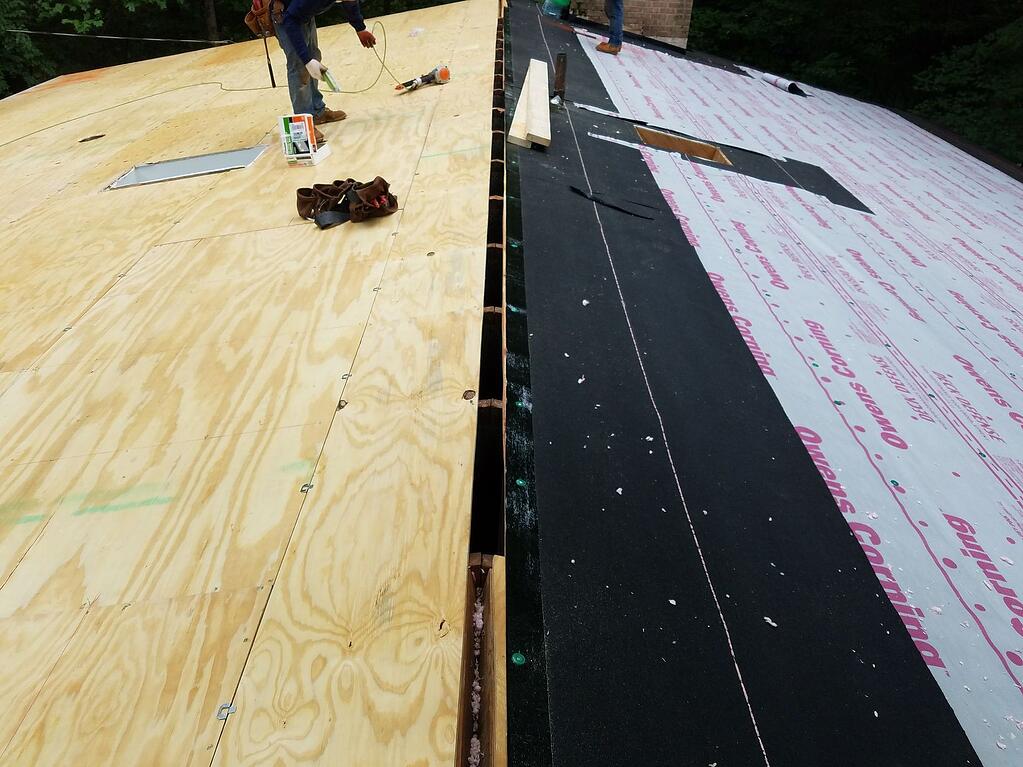Whether you’re a roofing expert or a total newbie, you may be wondering what exactly felt paper’s purpose actually is. We’re here to provide all the answers. You see, roof underlayments are crucial as they provide a necessary barrier of protection between your roof and interior residence. Felt paper is a type of roof underlayment. It’s required under many building’s codes and organizations such as the National Roofing Contractors Association (NRCA) recommend using it for every project. With various benefits, you’ll want to make sure you’re using felt paper for your next roofing project.
What is Felt Paper?
Felt paper is made from a base of natural (wood) or synthetic (fiberglass) materials. This is coated with a protective coating such as asphalt which repels water but allows the underneath product to breathe so air and humidity don’t get trapped. It’s a protective second layer that’s installed between the roof deck and roof shingles that seals and protects your roof against leaks.
Experts have found that adding this extra layer of protection creates a longer-lasting and stronger roof.
Benefits of Felt Paper
Repels Water
No one wants leaks, moisture damage, or mold growing on their roof! Rain or snow can wreak havoc on your roof if it’s not prepared for the elements. Felt paper gives you greater peace of mind that water is sealed off and draining properly right off of the roof. This means your home stays dry and comfortable all year round.
Emergency Backup Protection
Snow and ice are the main causes of residential water damage. Think of it this way, your home is heated and warm, so when snow or ice lands on your roof, it instantly melts and turns into water. Water can then leak into your home through all the little nooks in your roof if they aren’t protected thoroughly. This can cause insulation, ceiling, or wall damage. It’s best to be prepared with the extra layer of paper felt in place.
Meets Class A Fire Ratings
Shingles alone often don’t meet the Class A fire requirements. It’s best to choose an underlayment such as felt paper to comply with building codes and meet the proper fire requirements.
Weather Protection
Shingles are obviously your roof’s first line of defense against any bad weather that blows your way. But having an underlying layer helps extend and protect the life of your entire roof. If a tornado were to break your shingles loose, you would have protection from your home interior until the shingles could be replaced. Without this, the outdoor elements would literally be in your kitchen or living room until it was taken care of.
Protects During Construction Process
Having felt paper in place during the construction of your roof protects the bottom deck from being exposed. Before the shingles are installed, everything would be exposed to the elements without a protective layer. It also gives roof workers much better traction to prevent slips and provide a safer work environment.
Prevents Wood Resin Stains
Depending on what wood you choose to make your roof deck, there’s always a risk that resin will leak out and stain your shingles. A layer of felt paper will block any stains from occurring, which means you won’t have to replace shingles over time due to staining.
Improved Appearance
The layer of felt paper provides a more even look to apply shingles on. Roof decks aren’t always perfectly even, so having an extra layer to smooth things out will make your shingles and overall roof appear more uniform and put together, rather than sloppy and uneven.
Which Type Should You Use?
Homeowners typically pick felt paper over synthetic because it’s been around for a long time and it’s a well-tested option. It provides protection and can last for many years, and is easier to install than synthetic, which also lowers labor costs. It’s a great option if your budget is tight, you want a quick and easy installment process, or you know your roofer will be able to complete the job quickly to avoid element damages.
15 lb Felt ($)
- Easy to work with
- Cheapest option if you’re on a tight budget
- Very lightweight
- Tears easy when wet and doesn’t do well on its own in the elements (shingles should be installed quickly after applying felt to roof)
- Weighs between 7-12 lbs
30 lb Felt ($$)
- Harder to work with than 15lb felt
- Less prone to tears
- Thick & Stiff paper
- Heavier
- More weather resistant, however, shingles should be placed quickly to avoid wrinkling
- Weighs between 16-27 lbs
Synthetic ($$$)
Synthetic underlayments are a better choice if you want the highest quality protection available for your roof, if your roof deck will be exposed to the elements before your shingles are installed, or if you live in a rainy, snowy, or ice prone part of the world that needs a higher level of water protection.
- Much more expensive than felt paper
- Wide variety of materials available to customize your budget and performance standards
- More durable
- Light and easy to work with
- Higher labor costs to install
- Fewer repairs needed over time
- Less prone to mold and wrinkling (thanks to non-organic materials)
- More weather resistant than felt
- Installed using cap nails, not staples
- Forms a water proof barrier between the roof deck and the shingles if you ever have a blow off
- Your roofer can help determine which type would be the best fit for you based on your project and budget needs.
If you have any questions or are looking for help with your next roofing project, please feel free to give BRAX Roofing a call or request your free roof estimate






